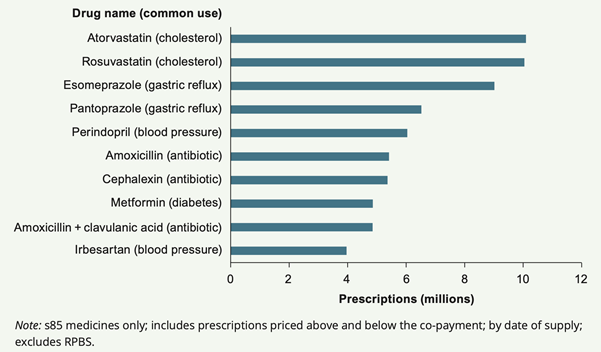FOUR Steps for Heart Health
Chart 1: Ten most common medicines, by number of PBS prescriptions dispensed, 2016-17

Source: Department of Health 2017; Table S7.6.4.
According to the chart above, four out of the ten most common medicines dispensed in pharmacies are related to heart disease. Heart disease is the leading single cause of disease burden and death in Australia. While the Australian death toll from COVID-19 related illness stands at 89, as of the end of April 2020, almost 50 people died from heart disease every day and 170 people experience an acute coronary event (heart attack or unstable angina) every day in Australia.
Heart disease occurs when there is a blockage in the blood vessels that supply blood to the heart muscle. Once one is diagnosed with heart disease, he or she may require long-term management and may often have complex health needs. Hence, it is important to keep our heart healthy with the following four steps of self-help and self-care.
1. Understanding your heart
If we are aged 35 – 75, we can use
the Heart Foundation’s Heart Age Calculator to
estimate our risk of a heart attack or stroke in the next 5 years.
If a calculated ‘heart age’ is
higher than our actual age, it indicates a higher risk of developing heart
disease.
Once we have discovered our ‘heart age’, absolute
cardiovascular disease (CVD) risk assessment (http://www.cvdcheck.org.au/calculator/) enables effective management of identified modifiable risk
factors through lifestyle changes and, where needed, pharmacological therapy.


2. Know your number
Hypertension is a significant risk factor for heart disease. Blood pressure assessment should be based on multiple measurements taken on several separate occasions, at least twice, one or more weeks apart. Home blood pressure monitoring is helpful to establish an accurate diagnosis.
The current definitions of hypertension are summarised in the table below. The general rule of thumb, lower is better because lowering blood pressure leads to reduced cardiovascular events.

Source: Heart Foundation Australia, Guideline for the Diagnosis and Management of Hypertension in Adult, Table 2.1
3. Take action
80% of heart disease is preventable, as many of its risk factors are modifiable. Lifestyle intervention is the first treatment strategy to manage heart disease. Below is the detailed guide on how to work on weight control and SNAP (smoking, nutrition, alcohol, and physical activity).
However, when it is difficult to control hypertension with lifestyle modification alone, antihypertensive medication becomes necessary. Constant high blood pressure (>140/90mmHg) has proven to damage blood vessel walls over time and often up to 70% of patients will need at least two antihypertensive drugs to control blood pressure. Here are two conditions where antihypertensive therapy should be started.
- When absolute CVD risk is low (< 10% 5-year risk) with persistent blood pressure is ³ 160/100mmHg
- When absolute CVD risk is moderate (10-15% 5-year risk) with persistent blood pressure ³ 140mmHg systolic and/or ³90mmHg diastolic

Source: Heart Foundation Australia, Guideline for the Diagnosis and Management of Hypertension in Adult, Table 5.1

4. Supplementing your heart
The scientific evidence shows that supplementing with certain vitamins prevents chronic disease, specifically CVD, various types of cancer and osteoporosis (JAMA June 19, 2002, Fairfield KM, Fletcher RH).
Here is the last step to optimise heart health and general wellbeing.
- Daily good multivitamin
- Super antioxidants such as Co Enzyme Q10 and bergamot
- Regular topping up with vitamin C and vitamin D


